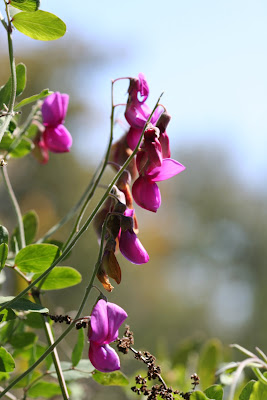The trailhead (with interpretive trail guide) starts at the parking lot of the visitor center. It's a short and easy hike at 0.6 mile and little elevation gain, with numbered markers along the way.
3/28/10 Granite Loop Trail
The seasonal creeks are still flowing and the wildflowers are in abundance. In terms of wildlife, Gil saw a Mule deer in the foliage, and we also caught glimpses of various lizards, butterflies, birds, and a hungry pocket gopher.
3/28/10 California Pocket Gopher (Thomomys bottae).
He was so !*&#@ cute, that I almost forgot how destructive these guys actually are. As we watched him popping in and out of his subterranean abode, we realized he was consuming every vestige of plant material within his immediate reach, including (eventually) those two lovely Baby Blue Eyes blossoms hanging serendipitously over his head.
Onto the wildflower segment. Here's the list of the blooming beauties we saw along the way:
Checkerbloom (Sidalcea malviflora ssp. sparsiflora)
Ground Pink (Linanthus dianthiflorus)
Angel's Gilia (Gilia angelensis)
Johnny Jump-Up (Viola pedunculata)
Purple Night Shade (Solanum parishii)
Southern Miner's Lettuce (Claytonia perfoliata ssp. mexicana)
Fringe Pod (Thysanocarpus curvipes)
California Peony (Paeonia californica)
Pomona Locoweed (Astragalus pomonensis)
Blue Dicks (Dichelostemma capitatum ssp. capitatum)
Wild Cucumber (Marah macrocarpus var. macrocarpus)
Dwarf Lupine (Lupinus bicolor)
Goldfields (Lasthenia californica)
Popcorn Flower (Cryptantha & Plagiobothrys spp.)
Owl's Clover (Castilleja densiflora)
Strigose Lotus (Lotus strigosus)
Wild Cucumber (Marah macrocarpus var. macrocarpus)
Baby Blue Eyes (Nemophila menziesii var. menziesii)
San Diego Pea (Lathyrus vestitus var. alfeldii)
Common Lomatium (Lomatium utriculatum)
3/28/10 Checkerbloom (Sidalcea malviflora ssp. sparsiflora)
3/28/10 Owl's Clover (Castilleja densiflora). Owl's Clovers and Indian Paintbrushes (Castilleja spp.) are hemiparasitic, meaning that they attach to and derive some of their nutrients from a host plant (e.g., grasses & sedges).
3/28/10 California Bells (Phacelia minor).
3/28/10 Ground Pinks (Linanthus dianthiflorus).
3/28/10 San Diego Pea (Lathyrus vestitus var. alfeldii).
3/28/10 Southern Miner's Lettuce (Claytonia perfoliata ssp. mexicana).
3/28/10 Johnny Jump-Up (Viola pedunculata).
3/28/10 Pomona Locoweed (Astragalus pomonensis).
3/28/10 Shady respite under a canopy of oak trees.
3/28/10 Approximately 300 year-old oak tree. According to the trail guide, 150 years is the average age of the oaks trees on the Plateau.
3/28/10 Fringepod (Thysanocarpus curvipes).
3/28/10 Johnny Jump-Ups (Viola pedunculata) adding pizzazz to the landscape.
3/28/10 Meadow of Deergrass (Muhlenbergia rigens). The Santa Rosa Plateau is home to one of the few remaining areas of native bunchgrass prairie in California.
3/28/10 Meadow of Deergrass (Muhlenbergia rigens). The Santa Rosa Plateau is home to one of the few remaining areas of native bunchgrass prairie in California.
3/28/10 An 'Acorn Cupboard'. In the fall season, our resident Acorn Woodpeckers will horde acorns in the trunks of dead tree parts. An artful masterpiece, IMHO...
3/28/10 Just a reminder that this wild "kitty" inhabits our neighborhood. Adult males can easily weigh over 150 pounds, and are magnificent to behold. I've only seen a Mountain Lion in the wilds once before in the Big Morongo Canyon Preserve (a desert oasis in the Little San Bernardino Mountains off Hwy. 62). Attacks on humans are very rare, but one must always be vigilant and just use common sense when hiking in their turf (same applies when hiking in black bear habitat).


















As the Ungardener always hopes that one day we will see a leopard, when we hike in the Groot Winterhoek Wilderness Area.
ReplyDeleteWildflowers, Oak Trees - some of my absolute favorite things. Mountain Lions - not one of my favorite things ;-)
ReplyDeleteArleen this is my kinda walk but maybe without the lions. I loved the old knarled tree in the background of the first photo and I saw those lovely fringepods again you've featured before - so many delights here for me to see - all unseen till I came to read here.
ReplyDeleteI think that acorn tree that the woodpeckers have left is awesome!
Now you gave me a lovely compliment last night on my blog about my photography - Arleen I only took the camera off automatic last Novemeber when I started blogging. I don't have an slr but my professional photographer friend has told me that my camera does almost everything an I would ever want an slr to do. I don't change lenses as it does it for me.
That snowdrop photo was taken in supermacro rather than macro - up extremley close to the subject.
My camera is a fujifilm finepix s8100. I have a manual too and the 2nd section of it still doesn't make sense to me. Some day I would love to figure it all out as I would like to manually manipulate the supermacro setting rather than let the camera do it for me as it focus's sometimes on the wrong thing.
My latest post is about a native wildflower which might interest you. I do have a set of links on my homepage about giving tips on how to photograph flowers. Not sure if it is mentioned about wildflowers but as far as I can remember its best to take the photos is in the early morning or later in the evening.
Have a lovely Easter weekend
:) Rosie
Wonderful photos... Just lovely!!
ReplyDelete